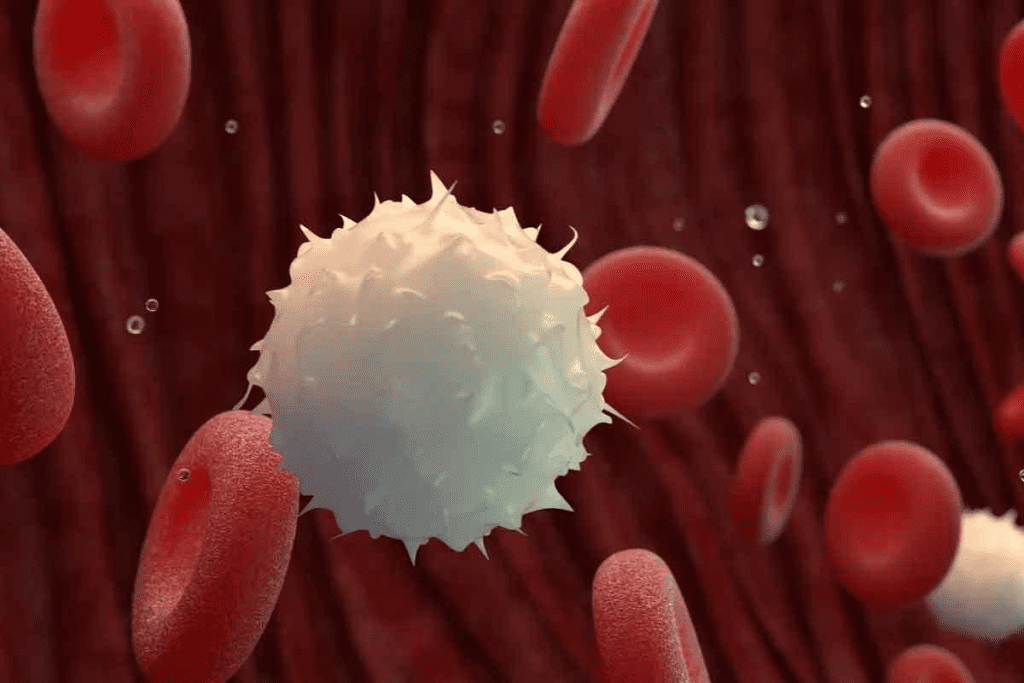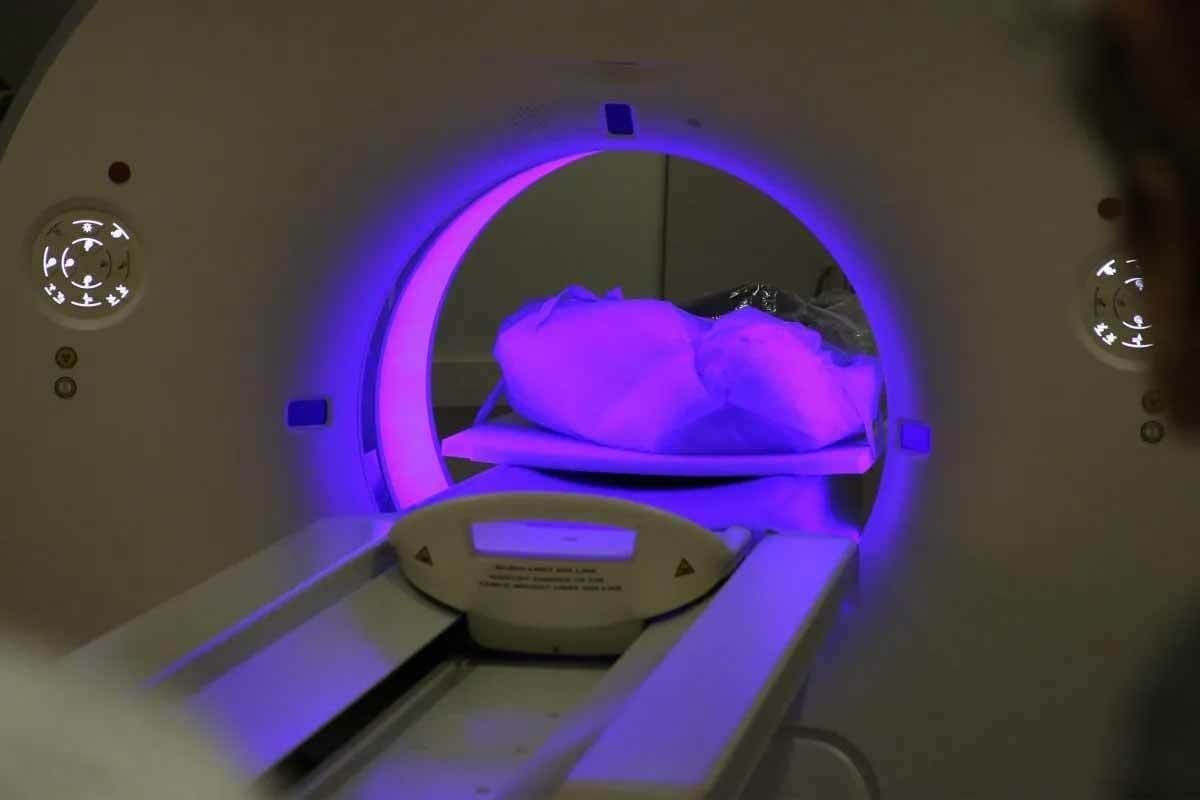Last Updated on November 27, 2025 by Bilal Hasdemir

Diagnosing infections and inflammation needs accurate tools. We use the Ceretec white blood cell scan. It’s a nuclear medicine test that finds where infections or inflammation are in the body.
The scan labels a patient’s white blood cells with a special tracer. This tracer goes to areas with infection or inflammation. It lets us see these areas clearly through nuclear medicine imaging.
At places like Liv Hospital, patient safety and care are top priorities. Every decision is made to ensure patients get the best diagnostic services.
Key Takeaways
- Understanding the Ceretec white blood cell scan process and its significance in diagnosing infections.
- The role of nuclear medicine in visualizing areas of infection or inflammation.
- Patient preparation and the importance of accurate imaging.
- The use of radiotracers in labeling white blood cells.
- The clinical decision-making process at institutions like Liv Hospital.
What Is a Ceretec Scan and How Does It Work?

A Ceretec scan is a key tool for finding infections. It’s also known as a white blood cell (WBC) scan or leukocyte scan. This scan uses nuclear medicine to spot infections or inflammation in the body.
Definition and Basic Principles
A Ceretec scan labels a patient’s white blood cells with a special tracer, Tc-99m HMPAO (Ceretec). This tracer goes to areas with infection or inflammation. It helps doctors see where the body is fighting infection.
White blood cells naturally go to infections. By labeling them, we can see where they go in the body. This helps find and measure infections.
The Role of Tc-99m HMPAO (Ceretec) Radiotracer
The Tc-99m HMPAO radiotracer is key for the Ceretec scan. The FDA label says it labels white blood cells for imaging. This makes it possible to see infections through nuclear medicine.
The Ceretec kit makes Technetium Tc99m Exametazime Injection. This is used to label white blood cells. This labeling is essential for finding infection sites accurately.
Differences Between WBC Scan and Other Nuclear Medicine Tests
The Ceretec WBC scan targets infections with radiolabeled white blood cells. It’s more specific than other tests. This makes it great for finding conditions like osteomyelitis, abscesses, and inflammatory bowel disease.
| Diagnostic Test | Tracer Used | Primary Use |
| Ceretec WBC Scan | Tc-99m HMPAO | Infection/Inflammation |
| Bone Scan | Tc-99m MDP | Bone Metastases/Osteomyelitis |
| PET Scan | FDG (Fluorodeoxyglucose) | Cancer, Infection, Inflammation |
The table shows how the Ceretec WBC scan differs from other tests. It highlights each tool’s unique features.
Medical Conditions Diagnosed Through White Blood Cell Scans

We use white blood cell scans to find many health issues. This includes bone infections and stomach problems. It’s great for spotting infections and inflammation that other tests can’t find.
Detecting Osteomyelitis and Bone Infections
Osteomyelitis, a bone infection, is hard to spot with regular tests. But a white blood cell scan can find it. It works by using a special tracer to mark infected areas in the bone.
Identifying Abscesses and Hidden Infection Sites
Finding abscesses and hidden infections is tough. But the tagged white cell scan is up to the task. It shows where white blood cells gather, helping doctors find and treat these infections.
Inflammatory Bowel Disease Assessment
White cell scan nuclear medicine helps with inflammatory bowel disease (IBD). It shows how bad the inflammation is in the gut. This helps doctors manage and treat IBD better.
Thanks to white blood cell scans, doctors can give patients better care. This leads to more accurate and effective treatments for many conditions.
Preparing for Your White Blood Cell Scan
A white blood cell scan, also known as a tagged WBC scan, needs specific preparation for the best results. We know getting ready for a test can be scary. So, we’re here to help you through the steps to make your experience smooth and successful.
Required Medical History and Documentation
Before your scan, sharing your full medical history is key. This includes any past illnesses, surgeries, allergies, and current medicines. We also need your medical records and any test results related to your condition.
Important documents to bring:
- Previous medical records and test results
- List of current medications and dosages
- Any relevant allergy information
Medication and Dietary Restrictions
Some medicines and foods can affect your scan. Tell us about any antibiotics, steroids, or other meds that might change the results. You might also need to follow special diets or fasting, as your doctor will tell you.
“It’s vital to follow the pre-scan instructions carefully to ensure the accuracy of the WBC scan radiology results.” -A nuclear medicine specialist
What to Wear and Bring to Your Appointment
Wear comfy, loose clothes on the day of your scan. Don’t wear jewelry or clothes with metal, as they might mess with the scan. Also, bring your documents, a list of your meds, and any other items your doctor asks for.
Tips for a comfortable experience:
- Arrive at least 15 minutes before your scheduled appointment time.
- Bring a book or other entertainment for any waiting period.
- Stay hydrated, unless your doctor tells you not to.
By following these tips, you can help make your white blood cell scan go smoothly. If you have any questions or worries, reach out to your healthcare provider for help.
Step 1: The Blood Collection Process
A Ceretec white blood cell scan begins with blood collection. This step needs precision and care. We aim to make it as comfortable as we can for our patients.
Amount of Blood Drawn and Procedure Duration
Adults usually have 40 to 80 mL of blood taken. This is needed to isolate white blood cells for the scan. The whole process takes 10 to 15 minutes, depending on the patient and the phlebotomist’s skill.
Comfort Measures During Blood Collection
We use a 20G needle to collect blood. This size balances blood flow and comfort. Our team is trained to make the process as painless as it can be. They might use a warm compress to help.
Special Considerations for Difficult Venous Access
Patients with hard-to-find veins get extra care. We might use ultrasound guidance or special techniques. Our goal is to make this step as stress-free as possible, even for the toughest cases.
Step 2: Laboratory Processing and Cell Tagging Techniques
The laboratory stage is key for isolating and tagging white blood cells. This step is vital for preparing cells for imaging. It helps us see and diagnose medical conditions well.
White Blood Cell Isolation Methods
White blood cells are separated from blood using special techniques. Centrifugation is one method, where blood is spun fast to separate its parts. This makes it easy to get white blood cells ready for labeling.
A study on the National Center for Biotechnology Information shows how important this step is for accurate imaging.
The Radiotracer Labeling Process
After isolating, white blood cells are labeled with Tc-99m HMPAO. This radiotracer lets us see these cells during the scan. A nuclear medicine expert says the labeling is done by mixing cells with the radiotracer.
This process needs careful conditions to work properly. It’s all about making sure the radiotracer sticks to the cells well.
Quality Control Measures to Ensure Accurate Results
Quality checks are strict in the lab to make sure the scan is right. These checks include making sure the cells are alive and the radiotracer is bound. The International Atomic Energy Agency says quality control is key in nuclear medicine.
By keeping standards high, we can rely on the leukocyte scan for treatment decisions.
In short, the lab work and cell tagging are critical for a white cell scan. By carefully isolating, labeling, and checking cells, we get accurate and trustworthy results.
Step 3: Reinjection of Tagged White Blood Cells
The tagged white blood cells are then put back into the patient’s blood. This marks the start of the imaging in a tagged white blood cell scan. It’s key because it lets the labeled cells go to infection sites. There, they can be seen during the next imaging.
The Injection Procedure and Timeline
The reinjection happens right after the white blood cells are labeled. The whole process is quite fast, taking just a few minutes. The exact time can change based on the medical facility’s rules and the patient’s health.
After being put back in, the tagged white blood cells move around the body. The timing of the next imaging is very important. It depends on the scan’s needs and the patient’s health.
Potential Sensations and Immediate Side Effects
Most people don’t feel much pain during the reinjection. But some might feel a tiny pinch or sting where the needle was. But serious side effects are very rare. Doctors watch for any bad reactions.
The process of putting tagged white blood cells back in is usually safe. Doctors are there to handle any worries or reactions right away.
Step 4: The Critical Waiting Period Between Injection and Imaging
The time between injecting labeled white blood cells and imaging is key in the nuclear medicine WBC scan process. This time, let’s the tagged cells move to infection or inflammation sites. There, they can be seen by the gamma camera during imaging.
Why This Time Interval Is Necessary
This waiting time lets labeled white blood cells reach infection or inflammation areas. It’s vital for them to gather in specific spots. This makes it easier to see and diagnose issues like abscesses or osteomyelitis with the white blood cell scan nuclear medicine method.
Activities Permitted During the Wait
Patients can usually move around and do normal things during this time. They should stay hydrated and comfortable. It’s also important to tell their healthcare team about any medicines or symptoms.
Managing Patient Comfort During Waiting Time
To stay comfortable, patients can read, listen to music, or relax. Using the restroom before imaging helps avoid interruptions. Our medical team is ready to help with any concerns or discomfort.
Understanding the waiting period’s importance helps patients prepare for the nuclear medicine WBC scan. This preparation can lead to a better diagnostic result.
Step 5: The Imaging Process with Gamma Camera Technology
Gamma camera technology is key in the Ceretec scan. It helps us find and check infections in the body. This tech is important for spotting where white blood cells gather, giving us important information.
Patient Positioning and Scan Duration
Patients lie on a scanning table, and then it moves into the gamma camera. The table is adjusted to make sure the right area is seen. The scan time varies, usually from 15 to 60 minutes.
How the Gamma Camera Detects Infection Sites
The gamma camera picks up radiation from white blood cells at infection spots. This radiation turns into images that show where infections are. These images help doctors know where and how big the infection is.
Multiple Imaging Sessions: Timing and Purpose
Sometimes, more than one scan is needed. These scans are done at different times, like hours apart or the next day. They help track how the infection is changing or if treatment is working.
Gamma camera tech gives us detailed images for diagnosing and treating infections. It’s a big part of the Ceretec white blood cell scan. It helps doctors make better decisions for their patients.
Step 6: Post-Scan Procedures and Radiation Safety
After the Ceretec white blood cell scan, we focus on your safety and the safe disposal of the radiotracer. Your well-being is our top priority.
Radiation Exposure Management
The Ceretec scan uses a small amount of radioactive material, Tc-99m HMPAO, attached to your white blood cells. We take careful measures to minimize radiation exposure to you and those around you. We follow strict guidelines to manage and reduce exposure.
Handling bodily fluids after the scan is important. We advise patients to follow proper hygiene practices, like washing hands thoroughly after using the restroom. This helps minimize radiation exposure to others.
When to Resume Normal Activities and Special Precautions
Usually, patients can go back to their normal activities soon after the scan. But, we recommend following some precautions for your safety and others. Drinking plenty of fluids helps flush out the radiotracer.
Some people, like pregnant or breastfeeding women, and those with certain medical conditions, need special precautions. We provide personalized guidance based on your health and scan details. It’s important to follow our instructions to avoid risks.
By following post-scan procedures and radiation safety guidelines, you can have a smooth recovery. This minimizes risks from the Ceretec white blood cell scan.
Step 7: Results Interpretation and Follow-Up Care
The leukocyte scan results give important insights into your health. They help doctors create a good treatment plan. After the scan, the images are studied to find infections or inflammation.
Timeline for Receiving and Processing Results
Usually, you’ll get your white blood cell scan results in 24 to 48 hours. Our team works fast to get the results right. This way, you can get the care you need quickly.
The time it takes can change based on how complex your case is. You’ll know when to expect your results when you first talk to us.
Understanding Your Scan Report and Findings
Your scan report will show where white blood cells have gathered. This means there might be an infection or inflammation. The report has different parts, like:
- A description of the scan and the radiotracer used
- Images and findings from the scan
- What a nuclear medicine specialist thinks about the results
- What tests or treatments might you need next
It’s key to talk about the report with your doctor. They can explain what it means and what to do next.
Next Steps in Your Treatment Plan
After your white blood cell scan, your treatment plan will change. It might include:
- Antibiotics or other medicines for infections
- More tests to see if the treatment is working
- Surgery if there’s a big infection or abscess
- More scans to check if the infection is getting better
We team up with your doctors to make sure you get the best care. We support you every step of the way.
Potential Risks and Considerations for Special Populations
Special groups, like pregnant women and kids, need extra care before a tagged white blood cell scan. We must weigh the risks and benefits to make sure it’s safe and works well.
Radiation Exposure Levels Compared to Other Procedures
The Ceretec scan uses a small amount of radiation from the Tc-99m HMPAO radiotracer. Radiation exposure is a big deal, mainly for sensitive groups. The dose from a WBC scan is lower than many other nuclear medicine tests. But, we must think about the benefits of the scan too.
For example, a WBC scan’s dose is about 4-6 mSv. A chest CT scan’s dose is 7-8 mSv. We look at these numbers when deciding if the Ceretec scan is right for our patients.
Pregnancy, Breastfeeding, and Pediatric Considerations
Pregnant women should avoid a WBC scan unless it’s really needed. If they must have it, we try to keep the radiation dose low. Breastfeeding moms might need to stop for a bit after the scan to keep the radiotracer from reaching their babies.
Kids are extra sensitive to radiation, so we use smaller doses based on their size and age. We decide on a WBC scan for kids carefully, balancing the benefits against the risks.
Patients with Allergies or Compromised Immune Systems
People with allergies to the Ceretec scan’s parts need careful checking. We look at the risk of an allergic reaction and take steps to avoid it. For those with weak immune systems, the scan can help find infections. But we handle the labeled white blood cells carefully to avoid problems.
In short, the Ceretec scan is useful, but we must be careful with special groups. By looking at each patient’s situation and taking the right steps, we can use this tool safely and effectively.
Conclusion: Advances in Ceretec Scanning and Future Developments
The Ceretec white blood cell scan is key in finding infections and inflammation. It uses Tc-99m HMPAO radiotracer, changing nuclear medicine. This scan is vital for doctors to diagnose and treat patients.
New technology in Ceretec scanning makes it more accurate and safe. The blood scanner now spots white blood cells better. This helps doctors find infections quickly and treat them effectively.
Looking ahead, Ceretec scanning will get even better. New research and radiotracer technology will open up more uses. This means doctors can handle complex health issues more effectively.
Ceretec scanning will keep being a major tool in medicine as it grows. Healthcare will keep improving with the latest tech. This helps doctors give the best care possible to their patients.
FAQ
What is a Ceretec white blood cell scan?
A Ceretec white blood cell scan is a test that uses a special dye to find infections. It labels white blood cells with a radioactive tracer. This helps doctors see where infections are in the body.
How does the Ceretec scan work?
First, white blood cells are taken from your blood. Then, they are labeled with a special dye. After that, they are put back into your body. The dye makes these cells show up on a scan, helping doctors find infections.
What is the role of Tc-99m HMPAO in the Ceretec scan?
Tc-99m HMPAO is a special dye used in the scan. It sticks to white blood cells. This lets doctors see where infections are using a special camera.
What medical conditions can be diagnosed using a white blood cell scan?
This scan can help find many health issues. It can spot infections in bones, abscesses, and other problems.
How should I prepare for a white blood cell scan?
Before the scan, tell your doctor about your health. Follow any diet or medicine rules. Wear comfy clothes for the test.
What happens during the blood collection process?
A blood sample is taken from your arm. It’s usually 40-60 ml of blood.
How are white blood cells isolated and labeled?
White blood cells are taken from your blood using special methods. Then, they are labeled with the Tc-99m HMPAO dye.
What happens during the reinjection of tagged white blood cells?
The labeled cells are put back into your body through a vein. You might feel some effects during or after this.
Why is there a waiting period between injection and imaging?
This wait lets the cells go to infection sites. This makes it easier for the scan to find them.
What happens during the imaging process?
You’ll lie under a camera that finds the labeled cells. This creates images of your body. The scan time depends on the test.
Are there any potential risks or side effects associated with the Ceretec scan?
The scan is mostly safe. But it might cause radiation exposure, allergic reactions, or blood collection issues.
How long does it take to receive the results of the Ceretec scan?
Results time varies by place and test. Talk to your doctor for details.
Can pregnant or breastfeeding women undergo a Ceretec scan?
Pregnant or breastfeeding women should talk to their doctor first. They need to weigh the risks and benefits.
Are there any special considerations for pediatric patients?
Kids need special care. This includes adjusting the dye dose and watching them closely during the test.
How does the Ceretec scan compare to other nuclear medicine tests?
The Ceretec scan is unique for finding infections. It uses labeled white blood cells and the Tc-99m HMPAO dye, unlike other tests.
What are the benefits of using Ceretec scanning technology?
Ceretec scans are very good at finding infections. They help doctors diagnose and plan treatment accurately.
References
- de Vries, E. F. J., Roca, M., Jamar, F., Israel, O., Signore, A. (2009). Guidelines for the labelling of leucocytes with 99mTc-HMPAO. European Journal of Nuclear Medicine and Molecular Imaging, 36(5), 835“841. https://www.ncbi.nlm.nih.gov/pmc/articles/PMC2844965/






